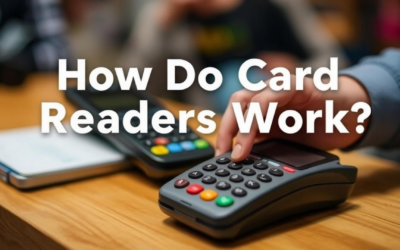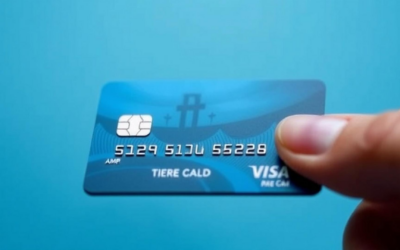How are card payment apps transforming business transactions?
Card payment apps have revolutionised how businesses process payments, making it easier, faster, and more secure to handle transactions. In a world where customers increasingly opt for card payments over cash, especially with the rise of contactless and mobile wallets, a reliable card payment app is essential for any business. From small market stalls to large-scale enterprises, these apps offer a flexible solution for accepting payments on the go. In this blog post, we’ll look at what card payment apps are, their key features, benefits, and the future trends shaping this technology.
What is a card payment app?
To begin with, let’s understand a card payment app. A card payment app at its core allows businesses to accept payments using mobile devices like smartphones or tablets without needing traditional point-of-sale (POS) hardware. This flexibility enables businesses to process payments in various settings—whether a physical store, a pop-up market, or while delivering goods and services directly to customers.
Card payment apps connect to a card reader or use near-field communication (NFC) technology to process payments from credit and debit cards. They support various transactions, including chip and PIN, contactless payments, and mobile wallets like Apple Pay or Google Pay. These apps are becoming indispensable tools for modern businesses by facilitating fast and secure transactions.
Card payment apps’ features
Card payment apps have various features designed to make payment processing seamless. These features enhance the user experience and provide security and convenience for businesses of all sizes.
Ease of use
One of the most significant advantages of card payment apps is their ease of use. Most apps are designed with user-friendly interfaces, allowing even those with minimal technical knowledge to set them up and accept payments quickly. This eliminates the need for complex training or specialised skills, making it accessible for businesses to adopt.
Transaction fees
When using a card payment app, businesses are typically charged transaction fees. These fees may vary based on the provider, and there are usually two common fee structures: flat-rate fees or percentage-based fees. Flat-rate fees are fixed per transaction, regardless of the amount processed, while percentage-based fees are charged based on a percentage of the transaction value. Understanding these fee structures is essential for choosing the app that best suits your business model.
Integration
Another key feature is the ability of card payment apps to integrate with existing systems. Many apps offer integration with POS systems, accounting software, and even eCommerce platforms, making it easier for businesses to manage all aspects of their sales and finances in one place. This streamlining reduces the need for manual data entry and improves accuracy across the board.
Payment processing speed
Speed is a critical factor in any payment system. Card payment apps are designed to approve real-time transactions, ensuring that payments are processed and confirmed instantly. Some apps also offer quick settlement times, meaning that funds from sales are deposited into the business’s bank account within a short period, typically one or two business days.
Security features
Security is a top priority for businesses and customers alike. Card payment apps employ robust security measures, including encryption and tokenisation, to protect sensitive data during transactions. Additionally, compliance with the Payment Card Industry Data Security Standard (PCI DSS) is crucial, ensuring that all transactions meet strict security requirements.
How to choose the right card payment app for your business?
Choosing the right card payment app can significantly impact your business operations. Here are some factors to consider when making your decision.
Business type and volume
The size and type of your business will play a key role in determining the best card payment app for your needs. For example, a small market stall may benefit from a simple, low-cost solution like SumUp, while a more significant business with higher transaction volumes may require a more feature-rich app like Square or Stripe.
Transaction costs
As mentioned earlier, transaction fees vary between different card payment apps. It’s important to compare the costs of various providers and determine which fee structure is most suitable for your business. Some apps charge flat fees, while others have percentage-based fees that may be more cost-effective for businesses with smaller transaction sizes.
Security and reliability
Security is paramount when processing payments. Ensure the card payment app you choose complies with PCI DSS and uses encryption or tokenisation to protect sensitive data. Research the app’s reliability—look for reviews and feedback from other users to ensure you choose a trusted provider.
Customer support
Access to responsive customer support can make all the difference when dealing with technical issues or payment disputes. Some card payment apps offer 24/7 support, while others may have more limited hours. Consider your business’s needs and ensure your chosen provider offers adequate support.
App reviews
Before committing to a card payment app, it’s a good idea to research what other businesses in similar industries say about their experiences. Reviews can provide valuable insights into the app’s performance, ease of use, and customer service, helping you make an informed decision.
How to use card payment apps?
Getting started with card payment apps is easier than you think. These tools are designed to simplify the payment process, making it convenient for businesses to accept card transactions quickly and securely.
Set up an account
You must set up an account once you’ve chosen a card payment app. This process usually involves providing your business information, such as your company name, address, and bank account details. Some apps may also ask for verification documents to confirm your identity and ensure compliance with security regulations.
Download the app
After creating an account, download the card payment app to your smartphone or tablet. These apps are generally available through their respective app stores for iOS and Android devices. Once installed, log in to the app using the account credentials you created.
Connect a card reader
Depending on your chosen app, you may need to connect a card reader to your mobile device. Many card payment apps offer small card readers that connect via Bluetooth or directly to your phone’s headphone jack or charging port. If you’re using an app that supports NFC (near-field communication) technology, you can accept contactless payments without needing additional hardware.
Start accepting payments
You can accept payments once your app and card reader are set up. To process a transaction, follow these steps:
- Open the app on your device.
- Enter the payment amount for the transaction.
- Ask the customer to insert their card into the reader, tap their contactless card, or use a mobile wallet like Apple Pay or Google Pay.
- Once the transaction is approved, the app will process the payment and display a confirmation message.
Issue receipts
Most card payment apps allow you to issue digital receipts via email or text, a convenient feature for you and your customers. Some apps may also offer the option to print receipts if you have a compatible printer.
Monitor transactions and manage your account
One advantage of using card payment apps is that they provide detailed transaction histories and sales reports within the app. You can monitor your daily, weekly, or monthly sales, track customer payments, and manage refunds if necessary. This data can be crucial for managing your cash flow and understanding your business’s financial performance.
Benefits of using a card payment app
The benefits of using a card payment app go far beyond just convenience. These apps offer a range of advantages that can positively impact your business’s operations, customer experience, and overall financial performance.
Convenience for businesses
One of the primary benefits of card payment apps is their convenience. Businesses no longer need to invest in expensive POS hardware; instead, they only need a smartphone or tablet to start accepting payments. This is especially useful for small businesses, pop-up shops, and freelancers needing a permanent location.
Increased sales
By accepting card payments, businesses can tap into a broader customer base. With the increasing preference for card payments over cash, companies that offer card payment options can see a boost in sales. Additionally, accepting contactless and mobile payments can speed up the transaction process, leading to shorter queues and better customer satisfaction.
Mobile flexibility
Card payment apps provide unparalleled flexibility for businesses that operate on the go. Whether selling at a market stall or a food truck or delivering goods directly to customers, a mobile payment solution ensures you can process payments anytime, anywhere.
Faster transactions
Card payment apps are designed to process transactions in real-time, significantly reducing the time it takes for payments to be approved and confirmed. This speed is especially beneficial in busy retail environments, where quick transactions can help keep lines moving.
Data insights
Many card payment apps have built-in tools for tracking sales, managing inventory, and analysing business performance. These insights can be invaluable for business owners making data-driven decisions to improve operations and increase profitability.
Challenges and considerations
While card payment apps offer many benefits, businesses must also consider some challenges and considerations before adopting this technology.
Transaction fees
Although card payment apps provide convenience, they come with transaction fees that can impact your bottom line. Businesses with small profit margins must carefully evaluate these fees and determine if the benefits outweigh the cost of using a card payment app.
Internet dependency
Most card payment apps rely on a stable internet connection to process payments. This can pose a challenge for businesses operating in areas with poor connectivity. With a reliable connection, transactions may succeed or take longer to process, leading to potential disruptions in service.
Security risks
While card payment apps employ advanced security features, fraud or data breaches are always risky. Businesses must ensure they use PCI-compliant apps and take additional precautions, such as regularly updating software and training staff on security best practices.
Customer trust
Not all customers may feel comfortable using mobile payment methods, particularly if unfamiliar with the technology. Businesses may need to educate customers on the security and reliability of card payment apps to build trust and encourage adoption.
Future trends in card payment apps
As technology evolves, card payment apps are expected to introduce new features and innovations to meet the growing demands of businesses and consumers. Let’s explore some key trends shaping the future of card payment apps.
Contactless and mobile wallets
One of the most significant trends in card payments is the rise of contactless and mobile wallet payments. Customers are increasingly opting for convenience, preferring to tap their cards or use mobile wallets like Apple Pay or Google Pay instead of inserting or swiping their cards. As this trend continues, card payment apps will likely focus on improving the user experience for contactless payments, making them faster and more secure.
AI and machine learning integration
Artificial intelligence (AI) and machine learning are growing in payment processing, particularly fraud detection and personalised user experiences. By analysing transaction data, AI can identify unusual patterns that may indicate fraudulent activity, helping businesses mitigate risks. Additionally, AI can provide personalised insights for business owners, such as identifying customer preferences and suggesting improvements for payment processing.
Blockchain and cryptocurrency payments
With the increasing interest in cryptocurrencies, some card payment apps are beginning to explore how blockchain technology can enhance security and reduce processing times. While still in its early stages, blockchain integration could enable faster, more transparent payment processing. Some card payment apps may also start accepting cryptocurrency payments, providing businesses with an alternative payment method for tech-savvy customers.
Omnichannel payment solutions
As businesses expand their presence across multiple online and offline platforms, the demand for omnichannel payment solutions is growing. Card payment apps will likely integrate more seamlessly with eCommerce platforms, in-store systems, and mobile devices to create a unified payment experience. This trend will help businesses streamline their payment processes and provide customers with a consistent experience, regardless of how they pay.
Global expansion
Card payment apps are also expanding their reach into emerging markets where traditional banking infrastructure may be lacking. By offering mobile-based payment solutions, these apps can provide businesses in developing countries access to digital payment systems, fostering economic growth and improving financial inclusion. This trend is expected to accelerate as mobile technology continues to advance globally.
FAQs
What is a card payment app?
A card payment app is a tool that allows businesses to accept card payments using mobile devices such as smartphones or tablets. These apps often require a card reader and can process transactions via chip and PIN, contactless, or mobile wallets like Apple Pay and Google Pay.
Are card payment apps safe to use?
Yes, card payment apps are designed with advanced security measures, such as encryption and tokenisation, to protect sensitive payment data. Most reputable apps also comply with PCI DSS standards, ensuring transactions are processed securely.
What fees are associated with card payment apps?
Card payment apps typically charge transaction fees, which can either be flat-rate fees per transaction or a percentage of the transaction value. These fees vary by provider, so it’s essential to compare options to find the most cost-effective solution for your business.
Can I use a card payment app without a card reader?
Yes, some card payment apps, like those that support NFC technology, allow businesses to accept contactless payments without needing a physical card reader. However, a card reader is often required for chip and PIN transactions.
What types of payments can I accept with a card payment app?
With a card payment app, you can accept various payment methods, including chip and PIN, contactless cards, and mobile wallets like Apple Pay and Google Pay. Depending on the provider, some apps may also support payments from international cards.







